2009 – A Year in Retrospect

2009 has been my busiest year to date since I’ve started blogging almost 4 and a half years ago and founded LandlordMax 6 years ago! Looking back, it’s hard to believe everything that’s happened. Which is why I’m going to take a breather today and look back at 2009, to share with you all that’s happened. Every once in a while I like to do that, and it’s been way too long since the last time.
When 2009 started, LandlordMax (the property management software company I founded) was growing at a very nice pace and the real estate market hadn’t collapsed as far as it has today. We were in the process of trying to release our biggest ugprade, version 6.05. We were also trying to get a Mac version out in the first half of the year, and hopefully get much further on the networked multi-user version. I had also just published my book Blog Blazers (November 2008) in which I had interviewed 40 top bloggers about their take on blogging. Above that I was in the process of a major redesign of this blog. Those were the major items on my plate as 2009 started.
Overall it mostly went as planned, with some surprises and exceptions. The biggest unexpected was just how much work it was going to take to make it all happen. If I had known ahead of time just how busy 2009 was going to be, I probably would’ve been a lot more stressed. Sometimes ignorance is best. In any case, here is my journey broken down into sections:
LandlordMax
Just to quickly re-iterate, LandlordMax is the company I founded about 6 years ago. The company primarily builds and sells property management software to real estate investors, property management companies, property managers, banks, colleges, and anyone else who needs to manage rental properties. The software manages the accounting, workorders, invoices, leases, tenants, buildings, and about a million other things. It’s a very useful and powerful piece of software.
When 2009 started, we were very actively working on a major upgrade of LandlordMax, which eventually was released as version 6.05 in May 2009. In it we included many new features, including a large amount of charting, email integration, Outlook support, whole new sections (accounts, contacts beyond tenants, vendors, etc.), over 20 new reports to the already more than 100 reports, and lots of other exciting new features. It was a massive undertaking that although started long before the year began, was finished before the year ended.
The only downside is that we couldn’t offer all the features we had wanted to and release it within a reasonable time. For example, we wanted to offer a feature we called “Archiving”, but as we tried to implement it, I realized it was going to be a major undertaking, taking more time than I wanted to get this version completed.
We also tried to get check printing into the software but had I to make the very hard decision to push it to a future release. After having committed a lot of time and money to check printing, it became clear that it wasn’t going to be doable within the time frame we had. So for now, this is a feature that has been put on hold. I hate to see all that effort put on hold, especially after having already invested so much effort and time, but it was the right decision. It was the hardest decision I that I had to make in 2009.
That being said, LandlordMax version 6.05 was very successfully released in May 2009. The feedback and comments we received have been amazing. Here’s just a few samples of the latest testimonials: 1, 2, 3. And those are just the ones I’ve published here on my blog, there’s many more on the LandlordMax Success Stories page.
Within days of version 6.05 being released, a big push went forward to make it available on the Mac. We’ve been working on this on and off for some time, going as far back as 2007. The problem with the Mac version is that there’s always tons of small and extremely annoying differences that need to be correctly handled. Things from how the installer works to how the program is rendered on the Mac. But this year I decided we had to make it happen no matter what. What I initially thought was going to be a certain amount of worked turned out to be a lot more than I had planned. And I mean a lot more! On the scale of 3-5 times more work!
Back in August 2009, I was already mentioning here how the Mac version was going to be coming very soon. That we only had one issue remaining. How wrong I was! A month later, in September I wrote about it again saying how wrong I was in my last post. We had resolved it, but now there were other issues.
One issue that was particularly troubling was due to the fact that LandlordMax is built on the Java platform. On the Mac, Leopard uses Java 5, and Snow Leopard uses Java 6. There is no overlap, and you can’t choose one version or the other, they each use a different version. Which means to support Leopard and Snow Leopard we needed to make LandlordMax fully Java 6 AND Java 5 compliant!! We’d been planning to upgrade to Java 6, but we were hoping to push that off until after the Mac version was released. Turns out we had to deal with it now.
At the end of October, we finally released the Mac version of LandlordMax! And it was compatible for all versions of the Mac OS, Leopard and Snow Leopard. Not only that, but you could take a backed up database file from the Windows version and move it to the Mac, and vice versa. In other words, you could use LandlordMax interchangeably on the Mac and Windows!
The Mac version of LandlordMax has since been received with lots of enthusiasm as shown in this initial testimonial, with many more to come. But in terms of estimated cost, we spent several times more than I had initially planned. And this is after having already committed lot of resources in the past.
During all this, the property management software market has dramatically changed. A company that’s been buying up many of our competitors over the last couple of years in the hopes of becoming a major player, Domin-8, has filed for chapter 11 bankruptcy. They acquired companies such as Rent Right, Spectra, Tenant Pro, iCam, Management Plus, and so on. This is big news because most companies have very limited success after filing for Chapter 11. Not only this, but we’re already starting to see people jumping ship as they’re learning the news. No one wants to be stuck with a software from a company that’s no longer around, especially with the speed of technology today. Which means 2010 may be a very interesting year for the property management software market. A shakeout year…
And as you all know by now, the real estate market has also been going through a major recession! You would expect our sales to be impacted negatively, but quite the contrary has been going on! Our revenue growth hasn’t stopped in the slightest, we’re still growing at the same fast rate as before as shown below (the graphs below only include sales of LandlordMax):

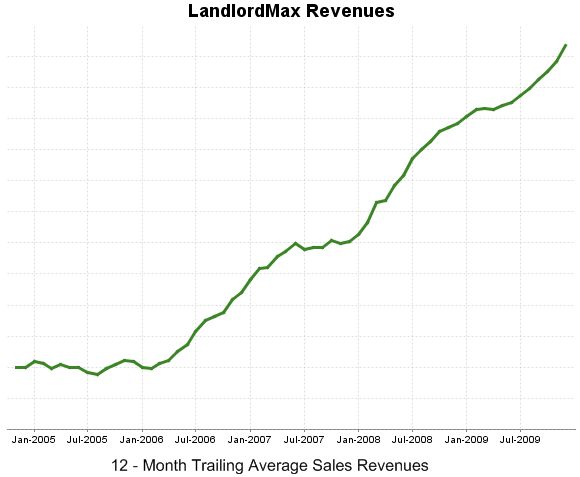
All in all, it’s been a great year for LandlordMax. Things have definitely been going in our favor. The only thing we haven’t yet succeeded in doing is releasing the networked version. A lot of work has already been done here, but the progress has been slower than I’d have liked. Not because it’s hard or a lot of work, which it is, but because I’m always having to allocate effort away from it to other more immediate items. For example, to get LandlordMax version 6.05 out on time, we had to pause the effort on the network version for several months. And for the Mac version, well let’s just say that all the effort was focused on the Mac version during those months. Like I said before, the Mac version required much more work than anticipated and I made the commitment to follow it through, even at the cost of delaying other items.
Which means that this year, we’re now working very hard on the network version. I expect there will be a new version of LandlordMax before the networked version is available, but I can’t confirm this. I also believe it won’t be until at least late in the year that the networked version will be available, if not in 2011. Above this, the website is in the process of going through a major uplift! That’s what’s going on right now. We’ll see what happens. I can’t wait to write a similar post when 2011 comes on what happened this year!
Blog Blazers
In November of 2008, I published the book Blog Blazers. In Blog Blazers, (also available on Amazon), I interviewed 40 top bloggers, (bios can be found here). The book took me a good year to publish and I’m very proud of the results. In it I asked everyone the same questions so that you the reader can compare apples to apples and oranges to oranges. Not only that, but one of my goals was to make sure the questions had a lot of follow-up material so that you could continue learning after you were done reading the book. Questions such as What was your most successful blog post ever? Which books and websites do you recommend to new bloggers? What’s your best tip for writing a successful blog post? To name just a few. I even wrote some follow up posts to help people find further resources such as 10 Most Popular Books in Blog Blazers.
Because the book was released in mid-November, it was just in time for the Xmas rush. And of course, because it’s a new book from a new company (Levac Publishing House – owned and operated by yours truly), there were some initial distribution issues. For example, Amazon will only initially order a limited number of books for new books and from new publishers. And because of this, Blog Blazers was almost immediately out of stock on Amazon. The good thing is that although it took alittle bit of time, we were able to resolve the issue quickly enough. And of course, it’s a good problem to have!
Other than that small initial glitch, Blog Blazers as a whole has been a pretty smooth ride. Most of the issues with the book were in it’s production, the marketing and sales was fairly similar to LandlordMax. Actually, I learned so much from the production side that I ended up writing a 3 part series on how to publish a book. Here is the link to the series: Part 1, Part 2, Part 3.
The biggest thing I learned about publishing books is that profits can only really be made by selling books in large volumes. You have to move at least 10,000-100,000 books to make any kind of money. Less than that and I’m at a loss how you can make any profit (assuming you have a marketing budget). The profit margins are definitely lower than I expected. To be honest, I really did learn a lot more than I ever expected about the book publishing industry. I now have a very big appreciation for the effort that goes into making a good book, and just how hard it is to produce and succeed. I now thing that books in general are under-priced. That being said, lots of copies of Blog Blazers were moved. Right now there’s just a fraction of what I initially printed left before I need to make a decision on the next print run. So that’s pretty exciting.
In regards to how the book has been received, it’s gotten a ton of glowing reviews. It’s been reviewed on major websites, blogs, magazines. It’s landed me several interviews, podcasts, radio spots, video reviews, guest appearances, etc. It’s been used used for a workshop at Drake University. What’s also very excited is that on Amazon, a site known for it’s reviews, Blog Blazers has gotten an average 4.5 star out of 5 stars! Almost no books get 5 star reviews, it’s extremely rare. Most books get anywhere from 3 to 4 stars. 4.5 stars is exceptional!
As the year has been wrapping up, I’ve had to decrease my marketing efforts. Right now the book is mainly selling itself through word of mouth. I might put another big marketing push or two, but I don’t expect to put as big a marketing push as I did in 2009. It’s a lot of work and because of that I believe it took a lot of my time away from LandlordMax. It was ok for 2009, but I can’t commit as much time to promoting Blog Blazers in 2010 as I did in 2009, not with everything coming down the pipe for LandlordMax.
Overall though, Blog Blazers was a success which I’m very proud of it. The only thing is that in retrospect had I known beforehand what it takes to publish a book I doubt I would have done it. The last time I had calculated, I put 1000-2000 hours into publishing the book. That’s just my time! This doesn’t include the money I invested. It’s definitely a costly endeavour. So if you’re planning to write a book, you should really check out my book publishing series I wrote on my blog (mentioned earlier). It’s a BIG project! Not that there’s anything wrong with it, it’s just nice to know what you’re signing up for before you actually do sign up.
FollowSteph
As always, in 2009 I continued to write articles/posts here. The biggest workload came from a complete custom re-design of the site. And I have to give credit to Reuben Whitehouse for it’s success. He designed the new logo, as well as the whole look and feel. If you’re interested, Reuben wrote a blog post about how he designed and came up with the FollowSteph.com logo. It’s a pretty cool post with lots of pictures and explanations on how he did it.
The other big news for FollowSteph is that the Feedburner subscriber count, which I don’t publicly post yet, has been climbing fast. In 2009, the blog grew in subscriptions by 500%!! I can’t even begin to describe how exciting that is!! Normally I’d see a 50% to 100% yearly growth, never 500% times. 2009 was a big year. Very exciting stuff!
For 2010, my main goal is to increase my blog postings, bring it back to my pre-2009 levels. 2009 was just so insane that I have to admit I didn’t post as much as I use to. Especially the last few months of 2009. In November and December I only had 2 posts each. My goal is to get back to my usual posting schedule of at least once a week, preferably more if time permits. It’s definitely not a lack of ideas and things to say, it’s a lack of time.
RealEstatePigeon.com
RealEstatePigeon.com is a completely new website/project sponsored by LandlordMax! I’ve never once talked about it. This is the very first time right now!
RealEstatePigeon.com is expected to be publicly released later this week or early next week. You’re more than welcome to check it out now, just be aware that we’re putting on the final touches as we speak. There are a few outstanding graphical issues. That and I’m in the process of seeding it a bit more before fully going public with it.
What is RealEstatePigeon.com? It’s a Q&A (Questions and Answers) website about real estate. The website is based on the success of StackOverFlow.com, a Q&A website for programmers. The idea is that you’ll be able to ask real estate related questions and get answers. Not only that, but because it’s a community website, you can also show off your real estate knowledge and answer questions posed by others.
The differentiator here is that unlike discussion forums where the answers are all listed in chronological order which makes you have to read everything just to get any idea of what’s going on, you’ll be able to quickly see the best answers. This will work because all the answers get voted on, and the best answers will get pushed up to the top based on the number of votes. So the better an answer is, the higher it goes and the quicker you can get to it.
Not only that, but the website is going to have a reputation based system. What this means is that you receive reputation points for each of your questions and answers that are up voted. The more reputation points you get, the more real reputation and credibility you get. And the more real reputation you have, the more real opportunities you’ll get offline, in the real world.
For example, on StackOverFlow people have gotten such high reputation scores that it’s attracted the attention of people looking to hire experts. Yes, opportunities are being presented to people directly because of their reputation scores! People are getting contracts because of their reputation scores. People are getting hired for work because of their reputation scores. Basically, people with high reputation scores are attracting the attention of others who want to work with them.
Therefore the goal of RealEstatePigeon.com is that not only will you get answers to your real estate questions, but you’ll will be able help others (and as a side effect show off your knowledge). And in return for helping others, you’ll be able to potentially achieve success yourself! Who wouldn’t want to work with a mortgage broker who had a high reputation score. What about a knowledgeable real estate agent? When you approach an investor for money, wouldn’t it be great to be able to show them how much you know and your reputation score? Even better, I can’t wait to hear from the first person who tells me they got approached by investors instead of them having to approach investors because of their reputation on RealEstatePigeon.com!! That’s the ideal goal! To get people come to you rather than you going to them!

2010
To summarize, in 2010 I plan to:
- Continue to grow LandlordMax
- Release at least one new major version of LandlordMax
- Get very close to releasing a networked and multi-user version of LandlordMax
- Finish the major uplift of the LandlordMax website
- Sell out all the remainder copies of Blog Blazers’ first print run
- More than double the number of subscribers to this blog
- Bring back to the posting frequency to pre late 2009
- Launch RealEstatePigeon.com with success
- And have a lot fun doing all of the above!!
Let’s see what happens.
Permalink to this article Discussions (4)
Why I Have So Many Printers
I hate to admit it, but I have more printers than I have computers. Why is that? Is it because I love printers? Not at all. It’s because it’s economically cheaper to buy a new printer almost every time I run out of ink.
For example, today on Amazon I can buy the Canon iP3600 Inkjet Photo Printer for $43.08. Don’t be fooled by the sale price, just do an Amazon search for printers in the $25-$50 range and you’ll find lots of printers in that price range. Many are cheaper than this Canon printer, I just picked it because the discount wasn’t as heavy as some of the other models.
Now if we look at the price of ink cartridge to replace it, what they call the value pack, to replace all the colors including black, it comes to $41.05. Yes, it’s actually cheaper to buy a new printer than to buy ink. And I get a new printer!!
I understand that ink is where printer manufacturers make their profits, and that more often than not the printers themselves are loss leaders, but this is a bit ridiculous. Is it just this one case?
Epson has a WorkForce 30 Color Printer selling for $59.99. To replace the ink requires a $16.49 purchase for black ink and a $32.99 purchase for color ink. Combined, that’s $49.48, just $10 shy of a brand new printer!
And it’s not just Canon and Epson that do this, pretty much all printer manufacturers are in the same boat. Too often the price of replacing the ink is equal to or greater than the price of a new printer.
I do understand that the ink packs they give you with new printers aren’t the same size as replacements, but most people don’t generally think about this when they’re in the store itself making the purchasing decision. What we’re thinking is in the first case I get a free printer. In the second, for $10 more we get a whole new printer!
With this in mind, it’s easy to understand why people such as myself have too many printers.
And don’t get me started on how shoddy most printers are built these days. How many printers have you had that lasted more than a year or two before they stopped working?
PS: The prices on Amazon have already changed from when I initially wrote this post.
Permalink to this article Discussions (4)
Should You Get Vaccinated for H1N1?
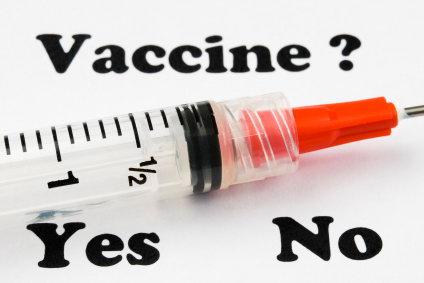
The quick answer: Yes! Absolutely get vaccinated. The quicker we can stop this virus in it’s tracks, the less chances we have that it mutates. Right now it’s a relatively mild virus, but it has has the potential to mutate. If we have the ability as a society to stop it before it can mutate, then we should. Not only that, but why get sick if you can prevent it, especially if you happen to be one of the unlucky few who gets hit really hard by it!
Because of all the media attention this vaccine is getting, and because it feels a bit rushed, a lot of people are somewhat skeptical of getting vaccinated. Today I’m going to try and answer as many questions as I possibly can about the vaccine. And although I’ve spent quite a bit of time researching this information, I’m still not a medical expert. Therefore if for any reason any information in this post is incorrect, please let me know right away.
How does the flu vaccine actually work?
Both the seasonal and the H1N1 flu vaccine work the same way. They basically help us create antibodies to fight the “real live” virus. How this is achieved is by injecting us with a tiny part of the DEAD virus. Again, it’s NOT live. And because the virus is dead, it cannot grow in us. But what it does do is allow our bodies to combat it, and hence build an immunity to it.
This is also generally why we don’t get sick from a vaccine. The virus is not live, and hence is not infecting us. It’s possible that we feel some minor flu like symptoms, and this is a good thing. It means our body is reacting to the dead virus and fighting it off, building antibodies.
Can flu shots cause the flu?
No. The vaccine ONLY contains DEAD virus. If you do get the flu after a virus it’s because you came into contact with it from another source, such as a door handle, a handshake, an infected air particle from someone coughing in the same room, and so on.
As well, do remember that the vaccine’s effect is not immediate. If you get the vaccine in the morning, you’re not immune that afternoon. The vaccine works by letting your body react to the dead virus, giving it the ability to pre-build antibodies before it’s exposed to the real live virus. Therefore you have to give your body the time to create these antibodies. For H1N1 it can be anywhere from 10-21 days for your body to build up it’s immunity.
Am I completely immune to the virus after I get vaccinated?
No. No vaccine is perfect! Most flu vaccines are 70-90% effective. It really depends on how closely matched the real virus is to the virus you were vaccinated for. So for example, if the H1N1 virus mutates significantly, then it’s possible that the vaccine’s effectiveness drops. Even more reason to get it now, so that we can stop it before it gets a chance to mutate. Studies have shown that if at least 70% of a population get vaccinated, it’s enough to extinguish most viruses.
In any case, right now it’s appears that the H1N1 vaccine is about 85% effective. That means that 15 people out of 100 people that got vaccinated will still get affected by the H1N1 virus.
The good news is that if you do get affected, it’s very likely to be much milder than if you didn’t get vaccinated. And if it does mutate, you may still have some partial immunity. Some immunity is better than no immunity.
Studies have also shown that people who get vaccinated do get sick less and miss fewer days of work.
Do healthy people need to get vaccinated?
Yes. Healthy people do get sick. Although in most cases their symptoms are much milder than the young and elderly. However when newer (for lack of better word) strains come out, such as the H1N1 flu virus, they are just at risk if not more so because of the Cytokine Storm produced by their body’s immune system. In the 1918 pandemic, it was the healthy young people that seemed to get hit the hardest.
If nothing else, although the symptoms may be milder to healthy people, they can potentially expose a lot of other people, such as their kids, their grand-parents, their parents, their grand-kids, their nieces, nephews, etc. Basically they can expose people who’s immune systems aren’t as robust as theirs.
What about the Guillain-Barre syndrome?
In 1976, a very small but unfortunate number of people developed GBS (Guillain-Barre Syndrome) after getting vaccinated (300 people out of 48 million). The vaccine that was given then didn’t go through the usual process like the H1N1 vaccine did. As well, even though it was never officially proven that the vaccine caused GBS, that vaccine is no longer used.
Studies have since then found that there is no difference between people who get flu vaccines and those who don’t in terms of getting GBS. But your chance of getting GBS after being sick from the flu is much greater than your risk of getting GBS after a flu shot.
In other words, getting the flu vaccine overall drops your rates of getting GBS. Do remember that the flu itself can cause swelling of the brain, it can cause comas, seizures, etc. The odds of getting GBS from the flu itself are higher than from the vaccine.
Is there mercury in the flu vaccine?
In some vaccines there are tiny amounts of thimerosal in the flu vaccine. Thimerosal prevents bacteria from growing in the bottle of vaccine. Thimerosal breaks down into a kind of mercury, but not the kind that causes mercury poisoning.
What are adjuvants?
Adjuvants are additives to vaccines to make them more effective. They basically cause your body to make more antibodies and to make them faster. It’s almost like pressing a turbo button on your immune system.
Adjuvants also help people with weaker immune systems since they aren’t as strong. Again, remember that the whole idea behind a vaccine is to expose your body to the virus and give it a chance to build an immunity to it. If your immune system is already weak, it may not be able to fully build up an immunity to it without a boost.
The other benefit of adjuvants is that it gives vaccine manufactures the ability to produce more vaccines in less time, which is great for rampping up vaccine supplies in times of pandemics. It does this because each flu vaccine needs smaller amounts of the dead virus to have effect. Less virus means less time reproducing large quantities of the virus. If H1N1 had turned out to be more virulent, or if it does ever mutate to a more virulent form, adjuvants will give us the ability to manufacture more vaccine quicker.
Are adjuvants safe?
Adjuvants are correctly considered to be safe. Most people don’t realize that many other vaccines do include adjuvants, some given to babies. They’ve been around for a long time. So far the results have been positive.
The only reason non-adjuvant vaccines are recommended to some groups such as pregnant woman is just because they’ve never been tested. It’s not because negative results have been found, it’s simply because there is no data. It’s actually been recommended that if push comes to shove for a virulent strain, and the choice is between an adjuvant vaccine and no vaccine at all, that the adjuvant vaccine be taken. It does appear to be safe, but it’s also hard to ethically test some specific groups of people (such as pregnant women).
How do you get the vaccine if you have egg allergies?
Unfortunately most flu vaccines are grown in eggs. If you have serious allergies to eggs, you may not be able to get the H1N1 vaccine.
That being said, I haven’t really done the full research into what options are avaialble for those with egg allergies, so if you do have these allergies, please feel free to comment below and let us all know.
Can kids become Autistic because of the flu vaccine?
There are two arguments people generally refer to when asking this question. Firstly, they point to the small amounts of mercury (the thimerosal mentioned early) as the cause. Studies have shown that this isn’t the case. In Denmark for example, thimerosal was taken out of the vaccines and it didn’t reduce the autism rate in that country. The WHO (World Health Organization) have also come to the same conclusion after several studies.
The second argument is that the rate of autism has gone up in correlation to the increase rate of vaccines. But if you remember your science 101, correlation doesn’t imply causation. Just because something is related it doesn’t mean it’s the cause.
For example, as the number of pirates have decreased, there has been an increase in global warming over the same period. Therefore the lack of pirates is the cause of global warming. Since the 1950s, both the atmospheric CO2 level and crime levels have increased sharply therefore CO2 causes crimes. In both of these cases it’s obivous that the correlation doesn’t imply the cause but sometimes the lines are fuzzier.
For example, as cell phones are being used more, autism rates have increase, therefore cell phones cause autism. I highly doubt this is true, but it’s a less obvious example. If you go one step further, as vaccinations have gone up, so have the rates of autism, therefore vaccines cause autism. Again, just because something is correlated it doesn’t mean it’s the cause. It’s back to the same type of argument: As ice cream sales increase, the rate of drowning deaths increases sharply, therefore ice cream is causing people to drown. Absurd, but it is actually correlated.
Conclusion
Should you or shouldn’t you get vaccinated? Yes, you should absolutely get vaccinated if you can. To be honest, there’s no reason not to.
Permalink to this article Discussions (0)
It's Only the Flu…

“Those who cannot learn from history are doomed to repeat it.”
– George Santayana
Why is there such a big push for the H1N1 vaccine right now? Why did the United-States declare a state of Emergency for the H1N1 virus? Why has the WHO (World Health Organization) been so public about escalating the H1N1 virus to a “pandemic”?
It’s because we’re learning from our past. Well hopefully we’re learning. Back in 1918 people were too slow to react to the biggest Pandemic in recorded history. And when they did react, it was either too late or too slow. The time to react is not once we’re in the midst of a full virulent pandemic storm. Rather the time to react is before it becomes virulent. Even with today’s modern medicine we still can’t cure the Influenza (Tamiflu isn’t really a cure). All we can do is prevent it and treat the symptoms.
Back in 1918, before it really struck at full force, people just kept saying it was “only just the flu”. Nothing to worry about. It’s just another cold. Yes, initially it was, but that quickly changed. And even then, many people still kept saying it was only just a flu. It wasn’t until people started dying, and even then it wasn’t for some time, that the population really started to react.
If you don’t know the history of the 1918 Influenza Pandemic, I strongly recommend the book The Great Influenza – The Story of the Deadliest Pandemic in History by John M. Barry. It’s an amazing read! The information and knowledge in the book is priceless! Not only does he follow you through the history of the pandemic, Barry also explains how influenza works and why we still need to be just as vigilant today.
The 1918 pandemic is chillingly similar to today’s pandemic. Firstly, the 1918 Influenza was an H1N1 Influenza virus, unlike the Avian Flu’s H5N1 makeup. If you’re not familiar, Influenza can come in a number of forms, H1N1 being one, H5N1 being another, and so on. Each form is different enough that if you have immunity to one it doesn’t give you immunity to another (so for example being immune to H1N1 doesn’t give you immunity to H5N1). This is why there are seasonal vaccines, there are just too many possible forms. As well, to make things more complicated, the Influenza virus can be different enough within one form to only offer partial immunity to that form (and in some cases none at all). It’s almost like variations within forms!
But getting back to the 1918 pandemic, it too started with an initial mild first wave. It’s the second wave that brought death and carnage to the world. The second wave was of the same form but much more virulent. So virulent in fact that in the most severe cases it killed within hours of when people showed the first signs of symptoms much like the death this week of the 13 year boy in Toronto who died of H1N1 with 48 hours of showing symptoms. Statistically, the 1918 flu killed anywhere from 2-20% of those infected as opposed to the normal rate of 0.1%! The good news is that in most cases it just made you really sick, but please don’t confuse that with how many people it killed. It killed complete families. It devastated whole communities. Governments in the US collapsed. Cities collapsed (Philadelphia, etc.). Booming cities became ghost towns. In terms of scale, it’s estimated to have killed over 100 million people. In today’s numbers that would be over half a billion people!
This is also incidentally why the WHO, and governments around the world, are pushing so hard for everyone to get vaccinated as soon as possible. We want to stop it dead it in it’s tracks, to prevent it from mutating into a much more virulent form. We don’t want to give it that chance. Not only that, we know that the H1N1 has the potential for being a real killer!
The similarities don’t just stop there, the H1N1 from 1918 was much more virulent to the healthy young people than to the young and elderly. Sadly, hundreds of thousands of children were left without parents after the virus had finished it’s run. Not something you normally see from the seasonal flu.
The reason it can be so deadly in young healthy people is because they are so healthy. It’s not actually the virus that kills them in many cases, it’s their own body. Rather than just sending in special soldiers and snipers from your immune system to attack the virus, it has to send in it’s full arsenal. Now in many cases, it’s not a big issue, but if the virus fights is strong, your body reacts accordingly (not exactly but close enough). So what happens is that you get your own personal World War 3 waged in your body. In most cases your body will win, but have you ever seen a battlefield after a big war? There’s not much of it left. In this case, the battlefield IS your body, specifically your lungs, so there’s not much left. This is called a Cytokine Storm.
This is often what causes you to die. And you’re lucky enough to survive the onslaught of the battle, your lungs are so beat up that they get secondary infections such as pneumonia, bronchitis, etc. In 1918 they didn’t know what to call this. Today we call it ARDS (Acute Respitory Distress Syndrome). If you get ARDS, your chances of survival are low. In 1918 you had a 10% chance of surviving. Today I believe it’s now up to a 50% chance of surviving. Better but not great. Incidentally, this is why SARS was so scary.
Just how fast can it happen? Here’s a story from the book The Great Influenza: “In Cape Town, South Africa, Charles Lewis boarded a streetcar for a three-mile trip home when the conductor collapsed, dead. In the next three miles six people aboard the streetcar died including the driver. Lewis stepped off the streetcar and walked home”.
Yes today we have better treatment for secondary infections such as antibiotics, but we definitely don’t have enough supply for a major pandemic. It’s believed that the world supply of antibiotics would be depleted early on in a significant pandemic, and manufacturers wouldn’t be able to keep up with demand. That’s part of the cost/benefit of our society’s “Just in Time” inventory. It helps reduce costs and wastage, but we don’t have much backlog. Again, we still have no cure for Influenza itself, all we have is medicine (antibiotics) to treat secondary infections.
Which is why we need to get the people who will be most sick (or most likely to pass it to others) vaccinated first. Not just because they’re more likely to suffer and die, but also because we want to be careful not to overwhelm our already over stretched medical system. In most places in North America, the medical system is already running at more than 100% capacity. That’s right, more than 100% capacity!
If you compare the medical system today to the 1918 medical system, they may have been better prepared. The hospitals back then were running well below 100%. In 1918 the bed per capita (ie number of beds for a given number of people) was much much better than it today. Even with this extra supply of bed and staff, you hear many stories from survivors who while in the hospital never saw a doctor. In some places people couldn’t get beds, even with bribes. People would lie on the floors waiting for others to die so that they could take their beds. It wasn’t pretty. And that’s with a bigger padding than today. It’s not about the quality of care, or what treatments are available, but just about being able to see a doctor!
It’s believed that our current medical system can’t even handle the extra surge from a mild pandemic! Never mind a virulent one. We just don’t have the resources for the surge in capacity. It looks like our hypothesis is about to be tested, and it’s already proving to be accurate. We are ONLY in a MILD Pandemic right now. Hopefully that’s all it will be.

The good news is that we have much better communications today. The fact that Barack Obama has already declared a state of emergency for the United States is phenomenal!! In 1918 it was hushed for as long as possible. Declaring a state of emergency early means we’re already starting to allocate resources before it’s a massive problem. It means we’re trying to prevent it rather than react. Not only that, but making people aware is a good thing. There may be some fear and panic right now, but compared to what happened in 1918, it’s way better.
In 1918 because they tried to hide the spread of the virus (it was during World War 1 and they were trying hard to boost morale – an Influenza pandemic killing millions doesn’t exactly boost morale), they created even more fear and panic. People had no idea what was going on. People didn’t trust anyone. Would you? It was a mess. Actually the cities that fared best, such as San Francisco, did so because they publicly shared truthful information. People were informed. Information was the key. And because they knew what was happening, what to expect, they dealt with it much better. The unknown is scarier than anything else. When you watch a scary movie, the anticipation up to the moment is the scariest. Once you see the bad guy, you’re no longer scared. The unknown is what’s scarier. So I only have praise for Barack Obama because he’s already started to allocate resources ahead of time. Great job!!
In terms of prevention, learning from 1918 (and other pandemics), it’s almost impossible to stop Influenza. This is why in the spring the WHO basically suggested there’s no point in stopping air travel. It was too late. With the Avian flu they still had a chance, but with H1N1 it was too late. It had already spread.
To give you an idea how far and wide it can spread, almost no one was safe in the world in 1918, before they had commercial travel like we have today. Even remote locations up in the North Pole got hit. Researchers were recently able to resurrect live samples of the 1918 Influenza from Alaska. The only communities that were able to save themselves from the 1918 Pandemic enforced very strict quarantines, almost to the point of being extreme. No ONE, and I mean NO ONE was allowed in once the quarantines were setup. Even something as innocent as a delivery of mail could devastate a community. Most communities failed, even with strict quarantines.
Yet still some were able to enforce quarantines where no one died. Communities such the town of Gunnison, Colorado. In October of 1918, in advance of the pandemic, they shut down the town for about 2 months. No public gatherings. Lawmen blocked all the roads. Train passengers weren’t allowed to get off the train to stretch their legs, not even outside. There’s even a record of a couple trying to drive through the town who got thrown in prison and quarantined. Basically they took very drastic measures but it worked. The neighboring town, Sargeant, esperienced 6 deaths of out 130 in one day. The quarantine worked. If you’re interested, you can find a list of newspaper clippings from 1918 with dates as the events unfolded here – it’s very informative.
Of course in our global world, it’s already too late. There’s no way to quarantine yourself. What you can do however is stay away if you’re sick. Please, STAY HOME IF YOU’RE SICK! This is how the virus passes. In our modern society, we’ve grown up to tough it out, throw some dirt on our wounds, and go to work. That’s the exact behaviors that cause the virus to spread. We need to change our way of thinking. If you’re sick, don’t go to work. Stay home. Don’t go out to public places. If you don’t need to go to the doctors then don’t. And especially, if you don’t need to go to the hospital then please don’t.
Even if you’ve been vaccinated, remember it’s not 100% effective. It’s 85% effective. You still have a chance of getting H1N1. However if you do get it, odds are that it will be much milder. As well, be aware that the vaccine is NOT immediate. It takes time for the vaccine to take effect. Your body has to build an immunity to it. It takes days, even weeks (I’ve read as much as 3 weeks with H1N1). In that interim, you CAN STILL CATCH the H1N1 flu. Each day you’re less likely, but you still can.
And please, please, please, if you already have the flu, don’t go get vaccinated while you have it. Firstly, it’s too late. Secondly, it won’t help, you’ve already gotten it. It’s not a cure but a prevention method! And this is why a lot of people think the vaccine is sometimes ineffective. If you were already infected but hadn’t yet shown signs (even more so if you show symptoms), it won’t do anything for you. It’s totally useless in that case. Again, it takes some time for vaccine to take effect, so you should get it sooner than later. The longer into the pandemic you wait, the less effect it will have.
For example, today in the news I read “Desrochers said she is anxious to be vaccinated because her grandson is sick with flu symptoms.” Are you serious? If you already have the flu, the vaccine is not going to help. It’s not going to make your grandson better. If anything, all you’re going to end up doing is infecting other people. It means you’re going to nullify the vaccine for everyone you come into contact with. It’s just wrong. But people are misinformed, and unfortunately the message being communicated is completely inconsistent.

I’ll give you another example. I was talking to someone locally who had just seen her doctor, and they informed her not to get the vaccine. The reason given was that it was a live virus and could be potentially dangerous because you needed a strong immune system to fight it. She is one of those high at risk. Her doctor couldn’t be more wrong. The vaccine available to her includes the dead virus, not the live virus. Secondly, she is exactly the high risk person that needs to get the vaccine. Why did it happen? Because the information traveling around is inconsistent. In marketing terms, there is no consistent message. That is to say, unless you educate yourself and your smart about what sources you refer to, etc., there’s all kinds of conflicting information. No one is stepping up and what’s happening is it’s creating misinformation, and hence fear and paranoia. We’re, sadly, repeating history in this case.
While I’m ranting, the other thing I don’t understand is why we aren’t delivering the vaccine faster. As far as I can tell here locally, it’s not the lack of vaccines that’s stopping us. What’s happening is that the vaccination clinics are only open for a few hours at a time before they decide to close down for the day so that they can close at their expected times. Don’t they understand, this is a race. It’s a race between getting the majority of the population immunized before the virus has the time to take hold, and in the worse case mutate to a virulent form. We’re not running out of vaccines right now. My local station giving the vaccine is only open between 2:30pm and 8pm. Within an hour the lineups are so bad that they have to close to let all the personnel go home by 8pm. At this rate, they’re vaccinating 4200 people in my city per day. Within a month, that’s approximately 100,000 people. In a city of about a million, that’s 10% of the population in a month, way less than majority needed. At that rate it would take until midway through next year just to hit 50%. Now I do understand that they are scaling up each day, but with doses available now, there’s no reason to close the vaccination clinics so early. If it’s a staffing issue, I’m sure there’s a solution to be found.
Since I’m on the topic of vaccinations, right now we spend more researching the West Nile virus than we do on Influenza, yet Influenza kills more people per year than the West Nile virus has killed since it was discovered. Why is that? With one pandemic, Influenza can kill more people than AIDS in several decades (the 1918 pandemic killed more people from Influenza in 6 months than AIDS has in 25 years). And not to downplay AIDS, but Influenza is much more transmittable than AIDS.
Not only that, but if you look at the economic costs of Influenza each year, just in terms of sick days, it’s very significant. It’s not a cheap virus. Why aren’t we developing a vaccine against all type A Influenzas, which would encompass all the different forms including H1N1. Because there’s not enough political interest, and hence not enough funding. If we could just invest 1%, or even 0.1% of what’s spent in Iraq (an accounting rounding error), I’m sure we’d make amazing strides forward. And the ROI (Return on Investment) would be significant. Imagine if we could wipe it out!
Alright, one last comment on vaccinations for now, if the vaccination effort is a success and the virus doesn’t have a chance to mutate to a virulent form, that is very few people die or get sick, what do you think will happen? People will start to complain that it was for nothing. That it was over-hyped. That it was a waste of time and money. That we scared ourselves for nothing. But did we? That’s success!!! Success IS that nothing happened.
If you think back to Y2K, did anything happen? No, because we invested millions, if not billions to prevent it. Unfortunately if nothing happens, people assume it was for nothing. Nothing happened on Jan 1, 2000. But you know what, a LOT of systems would have failed had we not put in such a big effort beforehand! Thankfully because of that big effort nothing happened. It was a success! Yet today people think it was over-hyped and not a big deal.
What about the Avian flu? Was that over-hyped? What happened? Nothing! Again, millions and millions of birds were slaughtered to prevent it from spreading. Every outbreak was quickly addressed. Thankfully the virus wasn’t too contagious and they were able to prevent a pandemic. A lot happened to prevent a pandemic. There’s a reason nothing happened. It was a success!
The same is true with 9/11. Before and after 9/11 many terrorists attempts were prevented. Of course we never think of that. All we think of is the one failure. Until something breaks down, it really wasn’t needed. It’s over-hyped. It didn’t do anything. That’s prevention. We need to be aware of why prevention is so important. An ounce of prevention is worth a pound of cure.
What are you waiting for, go get yourself vaccinated as soon as possible. Be a part of the solution, not the problem. Now’s the time to do something!
In the next little bit I plan to write about the vaccine, such as is it safe, what about this or that. If you want to make sure you won’t miss, you may want to subscribe here to get it by email as soon as it’s available.
Permalink to this article Discussions (5)
Why is Feedback Important?

Several months ago I had the bad luck of catch Strep Throat. Since I’ve had it several times in my life, I pretty much knew I had without having to see a doctor. But if you want antibiotics to treat it, you need to go see a doctor.
Before I continue, let me just say that the main reasons you want to treat Strep Throat with antibiotics is two-fold. Firstly in rare cases it can easily prevent some pretty severe complications. And secondly, you’re much less contagious.
In any case, I initially tried to see my family doctor but unfortunately he was unavailable for whatever reason, maybe he was on vacation or something, I just can’t remember. (by the way my current family doctor is the best doctor I’ve ever had – not only is he good, but he also cares!). Because I couldn’t see him, I went to a local walk-in medical clinic.
The doctor saw me, did a quick swab test, and of course the results came back positive for Strep Throat. However, for whatever reason, the walk-in doctor didn’t want to prescribe me any antibiotics. She was very adamant, saying that my body could, and should, fight it off naturally.
Now I understand there is a lot of abuse going on with antibiotics, but Strep Throat is an infection that can potentially lead to serious complications in some cases if not treated, and it was 100% certain I had it. Sure it might go away naturally, but let me tell you, once you meet someone who’s experienced the serious complications from this infection, you understand why they recommend treating it. So why not take the antibiotics, an ounce of prevention is worth a pound of cure. Plus, I’d be a lot less contagious.
But she refused. She said to go home, relax, and come back in a few days if got worse. So I left. But after a few hours, I had second thoughts and called the clinic. I explained that I had been diagnosed with Strep Throat, that the tests were 100% positive, and that it was highly recommended by the medical establishment to treat it with antibiotics. Not just to help fight the infection, but to help prevent any potential complications from the infection. Talking to doctor via the receptionist, she basically informed me the doctor really didn’t want to treat me with antibiotics and to come back in a few days if it got worse. I pushed some more and since it was near closing time, the receptionist said they would have to call me tomorrow.
The next day I decided to get a second opinion since I hadn’t heard anything by lunch time. I went to another walk-in clinic and saw another doctor. He quickly did another swab test and it was also positive for Strep Throat. He immediately gave me a prescription for antibiotics. I mentioned about the other doctor who refused to give me antibiotics, and asked why she wouldn’t just to get a better understanding. He said he had no idea, that with Strep Throat you should always give antibiotics. Again, this isn’t a sore throat, it’s a confirmed (now twice confirmed) case of Strep Throat.
Two or three days later, I forget now, I got a call from the initial medical clinic. This time the receptionist said that the original doctor that saw me wasn’t in today, but another doctor from the clinic would like to talk to me on the phone. She said, and I’m trying to remember the exact words as best as I can here: “You have Strep Throat and we HAVE to treat it with antibiotics. You can come in within the next hour to pick up a prescription, I’ll leave it at the front.”
Now you may ask, what was the point of this whole story? And how is it related to feedback? Well, if you look at the first doctor, she basically refused to treat Strep Throat with antibiotics. Since she’s not my family doctor, once I leave the clinic, she has no way of knowing whether her treatment was effective. Or worse yet, whether her treatment (or lack of treatment) helped or made things worse. She can only assume that things got better.
Let’s take this one step further. Let’s say her lack of treating me with antibiotics caused a rare kidney complication from the Strep Throat. How would she ever know unless I returned to tell her about it? She can’t know, and therefore she can’t learn from her mistakes. As far as she can tell her treatment was very effective since I didn’t come back.
How rare are the complications? I don’t know. But did you know it’s speculated that Mozart, the famous composer, may have died due to a kidney failure complication because of Strep Throat. Although rare, it does happens. But what’s worse is it’s so easy to prevent.
Getting back to our story, let’s say there are complications in 10% of the cases. How can any doctor from a walk-in medical clinic know (and learn) on the effectiveness of their treatments? As far as the first doctor who treated me can tell, there were no complications. No one came back. Although they might have ended up in a hospital, she wouldn’t know. She might not even be aware that another doctor from her very own clinic treated me with antibiotics. She could theoretically believe her treatment was right and continue treating her other patients the same way, re-enforcing her belief that her treatment (or lack of) works. A vicious cycle. And it’s really not her fault, there’s no way for her to know if it isn’t working.
Which is why it’s so important to have a family doctor. Unlike a walk-in clinic doctor who you’ll only see once, or maybe a few times over the years, your family doctor is going to be following-up with you on an on-going basis. Your family doctor is going to be getting feedback on their treatments. They’re going to see the results of their treatments firsthand and learn from them. They’ll know what works and what doesn’t. It’s not necessarily that one is better than the other (although it may be case), it’s that one has the chance to see the results of their actions, and learn from them, while the other doesn’t.
Feedback is the key! Without feedback how can you learn anything? How can you know if something really works if you never get to see the results of your actions? Feedback is the key ingredient in learning!
Permalink to this article Discussions (5)
How to Leave a Voicemail That Will Get Called Back

As part of opening up the technical support phone lines for LandlordMax a couple of months ago, we’ve chosen to let customers leave us a voicemail rather than waiting on hold on the phone until someone becomes available. I believe this is the best solution for us, and we call back pretty quickly.
That being said, we get all kinds of voicemail messages. Some are great and some are not so great. Unfortunately sometimes the messages are just too hard to decipher and we can’t call back. So today I’m going to share with you the keys to leaving a great voicemail. And this applies to both personal and business voicemails. In no particular order they are (other than the first three):
Introduce Yourself Clearly
First and foremost start your voicemail by stating your name and phone number before you start leaving your message. This really helps give context to the message. Although you may know who you are, don’t assume the other person knows who you are right away. Not only that, but if you start talking about a prior history and the person taking the message doesn’t know who you are or what history you’re talking about, then they’ll have to re-listen to the voicemail at least twice (maybe more) before fully understanding it.
Imagine that you’re the receptionist at a doctor’s office and you get a voicemail such as: “Hi. After all I won’t be able to make the appointment for tomorrow at 3pm that you scheduled earlier for me”. If you heard just that odds are pretty high you might not be able to put two and two together and figure out who the caller was. Not only that, but if there’s more than one person handling the voicemails, then the person listening to the message might be the other receptionist who has no idea of the history. Adding “Oh and my name is ….” is very helpful, but it would be even better if you could put it first. Without looking back, can you remember what time the appointment was at? Probably not, you’re too busy just trying to process the message that you have to go back and re-listen to it.
Another good reason to state your name and phone number first is that generally when you transcribe voicemails to paper you write the contact information first. It’s easier to sort and take notes if you have several voicemails to call back. This is true for both personal and business voicemails.
Speak Slowly And Repeat Your Name and Phone Number
When you leave a voicemail, say your name and phone number slowly!! Remember that although you know your name and phone number by heart, the other person doesn’t. If you rip it out at mach 10, it’s very hard for the person taking the message to decipher it, never mind write it down. We’ve all heard voicemails where the person says the number so fast we have to hear over and over and over and over again just to get it down on paper. Avoid this at all costs!
If you have an odder name like mine (Stephane Grenier), take your time to articulate yourself and say it clearly. If you quickly muffle through your name, especially in a low voice, the other person has very little chance of getting it right. This is especially true if you’re offended when people incorrectly say your name. The good news is that you don’t have to spell it out, you just need to pronounce it clearly.
Raise the Volume of Your Voice
Speak louder than usual. Some connections are terrible. Maybe your phone has a lower quality microphone. Maybe the other persons phone is of lower quality. Maybe the person taking the message is in a louder environment. Speak up. Don’t be shy. It really helps. On several occasions we haven’t been able to return calls because we just can’t hear the person. They speak so low or softly that we can barely make out anything. Combine that with someone who says their phone number really fast, and there’s no way you can decipher the voicemail.
Don’t Assume Caller ID
Just because caller ID is everywhere, don’t assume you don’t need to leave your phone number. The number you call from can be blocked. The person transcribing the voicemail might not have access to the caller ID information. And in many cases the phone number displayed through the caller ID is just wrong or inaccurate. This is especially true if you call from a business and all calls just display the main phone number for the business.
Don’t Assume Previous Knowledge
Having already mentioned this, don’t assume the person taking the message has any history of your previous conversation. Especially in a business environment. Even if it’s a direct line to the same person, they’re probably dealing with multiple people on a daily basis. It’s not personal, it’s just the way it is. We humans have limited memory capabilities, so let’s help each other out. By giving a context, you’re also helping yourself.
Don’t Assume I Know You Just By the Sound of Your Voice
Generally you can get away with this for personal voicemails, especially with close relatives and friends. but definitely don’t assume this in a business environment. And even with friends and family, don’t assume it. Maybe when you left the voicemail there was a lot of background, you had a cold, my phone isn’t very good, etc. Remember, assuming makes an a– out of u and me.
Leave a Phone Number That Can Be Called Back
If you want someone to call you back, make sure you leave them a number they can call you back at. Just today I got a voicemail from someone asking me to call them back. When I tried, it said: “This person is no longer accepting any calls”. I can’t call them back. Similarly if you call a business, leave a number where you can be reached during the business day. And vice versa for a personal voicemail to a friend to call you back at night.
Avoid Background Noise
As mentioned before, if at all possible, when you leave a voicemail try to keep the background noise to a minimum. You never know the sound quality that will come out the other end, so why make it harder for the person taking the voicemail.
Always Leave Your Phone Number
This one is much more true for business than personal voicemails. Just because we’ve talked on the phone several times before, it doesn’t mean that I have your phone number readily available. Just imagine you’re a banker and someone left you a voicemail to call back about the interest on their mortgage but didn’t leave their phone number because you’ve had several back and forth calls. Now for some weird reason you can’t find their phone number in your notebook (it’s there but you can’t find it), what do you do? You can then look it up on their mortgage application form, which hopefully it’s there. If not you can always look them up in the phone book. You have so much to do, maybe you’ll just call them back later this afternoon since you have to digg for it. As you can see, as the effort to find your phone number climbs the odds of getting a quick call back drop. And who knows, if you’re very unlucky, they may never be able to call you back! By leaving your phone number you can make returning your call that much easier. And we all know the easier it is to do something, the more likely it’s to happen.
Conclusion
Obviously there are other things you can do to improve your voicemails, but just these will make an incredible difference. If I had to keep it down to a sentence, I would say: “Always say your name and phone number clearly, slowly, and loudly”. At the very least, you’ll get a call back!
Permalink to this article Discussions (0)
Are Your Backups Actually Good?

Being the founder of a property management software business (LandlordMax), I can’t tell you how many times we’re contacted by people who’ve lost their data because of a hard drive failure, a complete computer failure, a virus, and so on. It happens all the time. So much so that a few years ago I wrote 4 Simple Steps to Protect Your Data From 99.9999% of all Computer Failures to help prevent this from happening to as many people as possible.
The good news is that today I’m seeing a lot more people pro-actively backing up their computers and their data. The bad news is that not all solutions are good. Whatever your backup solution is, you should test it before you NEED to use it. You might be surprised at how exactly it works. Or maybe it just simply doesn’t work. Maybe the automated backups aren’t actually backing up anything. Maybe it’s backing up the wrong files. Maybe the software you’re using is faulty. Whatever backup method, test it.
To give you an example, I was recently talking to a customer who was very active in her backup procedures. She knew that backing up was important, and she was very actively using a service to remotely backup her data in real time. I highly commend her for that, that’s better than most people. That’s exactly what we all want to see. I can’t praise her enough for being pro-active. And because of this she felt confident that her data was safe, which is completely reasonable, I would too.
However there’s one very big issue, and maybe you’ve already spotted it. If not, re-read the previous paragraph. Can you see it now? Her data was backed up in real time! If you think about it, this only protects you from a hardware failure or theft at best. And even then, if the harddrive is bad, you’ll still have the bad (corrupted) files overwrite your good files!! It only really protects you from a computer failure that’s very quick (power supply that shorts the machine) or theft. Maybe a few other situations, but it’s very limited. It doesn’t protect you from a bad harddrive, you’ll just push the same bad data to the backup service as the files get corrupted. It doesn’t protect you from a virus, the virus is just pushed over to the backup. It doesn’t protect you from accidentally deleting a file, the file is just as fast deleted on the backup!! Real time backups are good for backing up you system as it is exactly right now, good AND bad!
In other words, real time backups can be very limiting unless you can revert to a previous day, week, or month. And because most of these services are low cost, they don’t really offer these options. They just can’t, it’s not economically possible. For example, the solution use by the previously mentioned customer charges $54.95 a year for real time backups. If you look at the numbers, that’s less than $5/month for unlimited storage. I did notice that in her case the bandwidth was really slow, an 8MB file took about 15 minutes to restore. I would also assume support is about as good as $5/month hosting. But ignoring that, how can they feasibly offer tagged (dated) backups at those prices? Would most consumers pay $100/year for backups? My guess is probably not. Which means you won’t be able to revert to a previous version, just to your current version, whether it’s good OR bad.
Which means that if you overwrite a file, it immediately overwrites your backup. You can’t revert. You can only get what’s on your disk right now. The same is true if you’re infected. All you can do is get back the infected files. The only time it will save you is if you’re computer dies suddenly due to a hardware failure, theft, or other even less likely events.
So the moral of this post, whatever your backup solution is, I strongly recommend you verify it before you NEED to use it. You may be in for some surprises. The backup disk may not work. The backup system may not actually be backing up anything. Can you get a previous backup that’s not from today (in case you have a virus)? How long will it take you to get your computer back up (at 8Mb/15 minutes, a 1 GB backup could take days!!)? Don’t just think because you have a backup solution that you’re good to go, test it!
Permalink to this article Discussions (7)
Can Google Trends Predict the Winner?
For those of you who don’t know, Google Trends is a free service by Google that lets you determine the trend of different keyword searches over time, and then compare them together. Today I’m going to show you that it’s often possible to determine who will win between competitors using just Google Trends. By the way, did you know that Google can predict the flu activity up to two weeks faster than the current medical system? Yes, it can be that powerful!
LCD TV versus Plasma TV
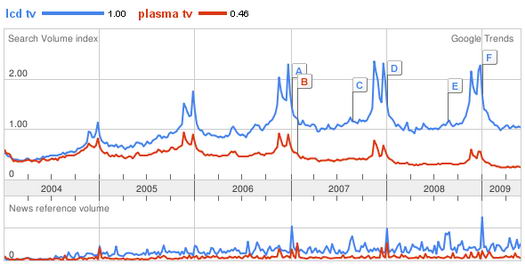
As you can clearly see, the number of Google searches for Plasma TV’s is on a clear decline whereas the number of Google searches for LCD TV’s is climbing. Based on the current trend, I predict it’s only a matter of time before Plasma TV’s are obsolete.
Another interesting thing to note about this graph is the spikes near the end of the year. This is inline with the increases in shopping for Black Friday and Xmas.
Facebook versus MySpace
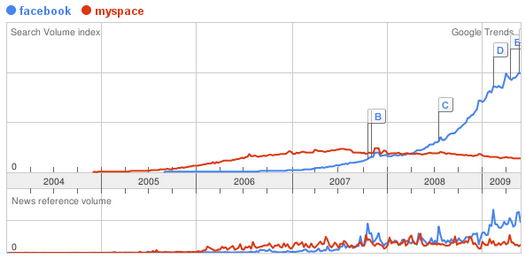
I remember how not very long ago everyone was wondering which would be bigger. Looking at the Google Trend it’s pretty clear who’s going to be bigger. FaceBook is continuing to grow while MySpace is declining. Although we can’t know for sure what the traffic numbers are, I’m willing to bet Facebook is ahead and gaining just like the Google Trends indicate.
When I wrote my ebook How to Generate Traffic to Your Website, I only had the Google Trends up to early 2008 (where they prettty much overlap and there’s not yet a clear winner), and even then I stated: “As you can see MySpace looks like it has already peaked, and may even be on the decline whereas Facebook has only recently peaked [in retrospect what looked like peak was only a temporary slowdown]. Please note however that these graphs don’t indicate real traffic but rather search query trends over time. If I was going to invest some time and/or money on one of these social networking sites, I would choose Facebook over MySpace based on these trend graphs.” A perfect example from a year and a half ago on how you can use Google Trends to better predict the future.
Netflix versus BlockBuster
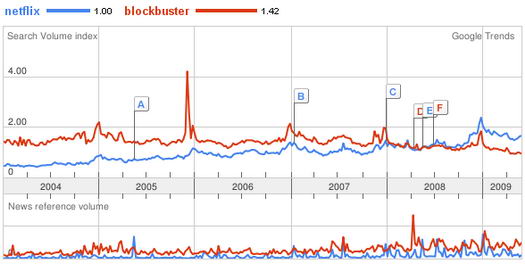
Based on the above Google Trends, it’s again pretty easy to conclude that Netflix is going to win over rental movies (I use Blockbuster since they’re the biggest brand name). Already Netflix has overtaken BlockBuster, and Netflix has an upward trend whereas BlockBuster has a downward trend. So unless things change, this lead should only widden.
Tivo versus PVR versus On-Demand
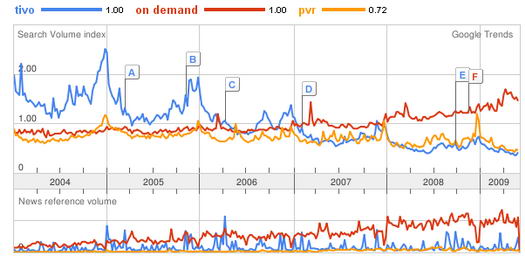
Based on these Google Trends, it appears that On Demand is growing faster than both Tivo and PVR’s. Tivo is definitely shrinking, and I expect it will eventually go away. PVR’s seem to be pretty static, which means they’ll probably stay with us for a long time. But On Demand is definitely a growing trend. If I was a betting man in the entertainment business, I’d put my money on On Demand as the way of the future.
Google Maps versus Mapquest
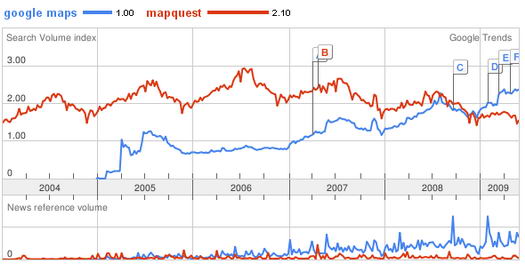
I remember how exciting Mapquest was when the internet was new. It was the first big website to offer you the ability to map direction from where you where to were you wanted to go. Since then things have significantly changed. Google Maps has come onto the scene. And have they ever. They’ve blasted right past Mapquest. I can’t imagine this trend reversing, especially not when you consider what all Google Maps has to offers over Mapquest.
Norton versus McAfee versus Nod32 versus Kaspersky

Years ago it used to really be a battle between Norton and McAfee. Today things have changed a lot. I can tell you from personal experience, I’ve used both McAfee and Norton and I dislike them both. They’re so performance hungry that they really hamper your machine. These days I use Nod32 and I have only good things to say about it. The performance of Nod32 is amazing. What a difference!
In any case, you can clearly see that the lead Norton had is now gone. Not only that, McAfee is also losing steam. What’s interesting though is that it looks like the old guard is going to be replaced. I picked Nod32 because I like it a lot, and Kaspersky because I’ve heard good things about it, but there are many others. Needless to say, these two are growing while the while Norton and McAfee are shrinking. I predict it’s only a matter of time. If it wasn’t for stores like Best Buy stocking Norton and McAfee on their shelves, that and corporations staying with what they’ve always bought in the past because change is hard, the numbers would be even more drastic. I predict it’s only a matter of time.
Network Solutions versus GoDaddy
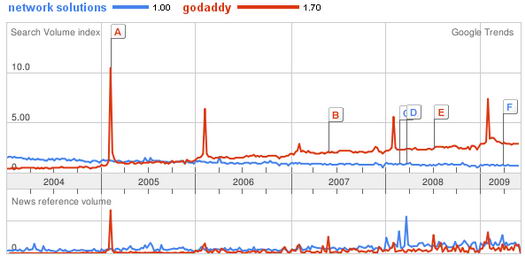
Back in the early days of the internet there were only 3 domain registrars, one of them being Network Solutions. Eventually this changed, and now we have more registrars than I can count. But what’s interesting here is that we can see that just because Network Solutions had an early lead, it doesn’t mean they will keep it. Remember they were one of only three registrars! What happened? They kept charging very high prices for domains hoping to bank on their brand recognition.
Along came GoDaddy with cheap domain registrations. Today we can clearly see that Network Solutions is going in a downward trend while GoDaddy is going upwards. It’s easy to see this lead growing with time.
SSD versus HDD
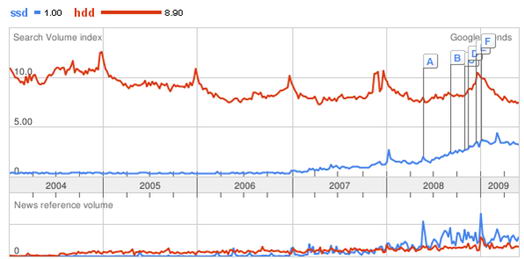
For those who aren’t as familiar with these abbreviations, SSD represents Solid States Drives and HDD represents Hard Disk Drive. HDD’s are currently the standard disks you find in computers. It’s most likely what you have in your computer. SSD’s are the new storage technology. They destroy HDD in terms of performance. They aren’t just a bit faster, they are multiple times faster. Not only that, they use a fraction of the energy, can take more physical abuse, have no moving parts, make no noise, and so on. Basically they trump HDD’s. The downside is that they’re still expensive, several times more than a standard HDD and they only come in smaller sizes. It’s more than enough space to run a normal computer, but I wouldn’t recommend storing larger media files on it just yet, it’s still too expensive.
In any case, you can see that HDD searches are going down while SSD searches are increasing. I predict it’s only a matter of time before SSD’s win out over HDD’s.
Conclusion
In many instances it’s possible to predict a clear winner by using only Google Trends. However you still need to use your brain, it’s not always correct. When I ran Blue Ray versus HD DVD, HD DVD was winning at the time, and it appeared it was going to win. I remember reading all kinds of articles and posts on how HD DVD was going to win. But then suddenly Sony made some deals and the majority of the studios made commitments to Sony’s Blue Ray technology. Within a month, it was all over. Blue Ray beat out HD DVD. However if it wasn’t for a direct intervention by Sony, I suspect things would be very different now. Having already gone through and lost the Beta versus VHS battle years ago, Sony wasn’t about to replicate it’s mistake one more time with Blue Ray versus HD DVD.
Overall though, you can, and should, definitely take advantage of leveraging Google Trends to predict the future. It’s the most powerful tool I know for predicting the future.
Permalink to this article Discussions (1)
8 Types of Headlines that Compel Your Readers to Action

Note: This post is mainly an exert from my ebook How to Generate Traffic for Your Website:
A headline has 5-7 seconds to get the attention of a reader. Not only that, but statistics show that only 2 out of 10 readers will read past your headline. That means if you’re going to hook your reader, you need to do it right away.
To give you a more concrete example of just how powerful a headline can be, John Wesley submitted an article to several social networking sites, including Digg, Reddit, StumbleUpon, etc. The headline read “The Two Types of Cognition”. With this headline the article generated about 100 visitors. Nothing spectacular. However a couple days later, and after some work rewriting his headline, John resubmitted it with a new headline. With the new headline it got about 5000 visitors. A very significant difference, 50 times more visitors. What was the difference? Only the headline. The article was exactly the same. The headline went from “The Two Types of Cognition” to “Learn to Understand Your Own Intelligence“. You can find the details of his case study here.
Headlines can and do have a significant impact. It might only be one line, but it can easily make or break your articles success.
In addition to grabbing the person’s attention, the headline must offer some value to the reader in exchange for them taking the time to read your content (article, press release, etc.). According to the legendary copywriter Robert Bly, there are eight categories of headlines that compel readers to take action and read your article. They are:
- Direct Headline: These are straight forward headlines that state exactly what they want, they make no attempt whatsoever to be clever. An example is “LandlordMax – 30% off today only”
- Indirect Headline: These headlines are subtle, what could be considered as link bait. They usually try to generate curiosity by the reader, or offer a double meaning in their headlines. In others words the classic link bait approach.
- News Headline: This is a direct news announcement. For example “LandlordMax releases version 6.05”.
- How to Headline: This is exactly as you would expect, it’s a headline that offers you an article on how to do something. For example how to fix a broken faucet.
- Question Headline: This category of headlines ask a question that the reader can relate to, that they can empathize with, something they would like answered. A classic example is “Who else wants to make a million dollars in the stock market?”
- Command Headline: This headline states what the reader of the article needs to do. For this headline to work the first word needs to be a strong and commanding word. For example “Buy this EBook now!”
- Reason Why Headline: This is basically a list of why something is good or bad. For example “3 ways to be more productive with your time”.
- Testimonial Headline: In this case the headline is a customer testimonial. This is done to offer outside proof, otherwise known as social validation. You’re validating through social proof that your article (or product) is great and worth the readers time. After all it’s not just you who says so, someone else is saying it too.
For further reading on headlines I recommend any book by Robert Bly. As well the book Advertising Headlines that Make You Rich contains a list of good and usable headlines (with a short explanation on how to use each headline). And don’t forget to check out Brian Clark’s blog CopyBlogger.com, he’s got a lot of amazing articles on how to write headlines. Good luck and good writing!
Permalink to this article Discussions (3)
How to Get the Best Possible Technical Support

It’s early Tuesday morning and you’re just entering your trusted car mechanic’s garage because last night your car was really acting up on your way home from work. You don’t know exactly what’s going on, but there’s no doubt that something is really wrong. The mechanic greets you with a smile and asks you what he can do for you to which you reply “my car is broken”.
What do you think happens next? Is this enough information for the car mechanic to help you?
No, not even close. Firstly, what do you mean by it’s broken? Does the car start? Is the windshield broken? Does the car make any noises? Does it rattle? And so on.
Basically the mechanic will first try to get a basic assessment of what’s going on. Saying the car is broken just isn’t enough. It’s much too generic with too many possible meanings. The mechanic needs to know more.
The exact same is true with software technical support. If you truly want to maximize the effectiveness of the help you’ll get from the support department, give them as MUCH RELEVANT information as you can.
For the car mechanic, you could say something like the car makes a loud rattle, but only when I turn. And this only happens if I’m going at least 30 mph or more. I’ve also noticed that it’s coming from the back left section of the car. I just started last night, I hadn’t heard anything before.
When it comes to support, a surprising number of people seem to just say things like “the software is broken”, “it no longer works”, “I can’t use it”, “it won’t let me close”, “it won’t let me enter my data”. All of these are too vague and to do any real troubleshooting with unless there’s more information to give it a context.
For example what does it’s broken mean? Does the software start up? Are you getting an error message? If so what is the error message? Is it a report that’s not generating the results you’d expect? Are you not able to perform a specific task? The list of possibilities are endless.
And please don’t take this post as me complaining about our customers, because it’s not at all about that. I really do appreciate all of our customers. What I’m trying to give here are some tips to help everyone (me included) to get the best support experience possible. And this isn’t just with us, but with every company out there. Not just software, but with anyone you’re trying to get help from. The more context you can give the better your results will be.
Imagine going to the doctors and just saying you don’t feel well. What does that mean? Do you have a headache? Do you have a stomach ache? Are you bleeding profusely (well you would hope that one would be obvious)? Did you bruise something? The list of possibilities are endless. You have to give your doctor some context so that they can help you.
The same is true with technical support. The more context you can give the better your results will be. I know we always appreciate it when people give us more details. And more importantly, it lets us respond immediately without having to send a request for more details. Adding relevant details and context is a win-win scenario for everyone.
Permalink to this article Discussions (2)
| « PREVIOUS PAGE | NEXT PAGE » |







